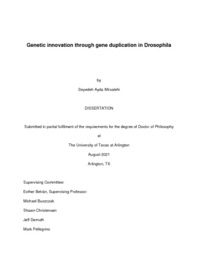
ATTENTION: The works hosted here are being migrated to a new repository that will consolidate resources, improve discoverability, and better show UTA's research impact on the global community. We will update authors as the migration progresses. Please see MavMatrix for more information.
Show simple item record
| dc.contributor.advisor | Betrán, Esther | |
| dc.creator | Mirsalehi, Seyedeh | |
| dc.date.accessioned | 2023-06-27T23:36:58Z | |
| dc.date.available | 2023-06-27T23:36:58Z | |
| dc.date.created | 2021-08 | |
| dc.date.issued | 2021-08-13 | |
| dc.date.submitted | August 2021 | |
| dc.identifier.uri | http://hdl.handle.net/10106/31343 | |
| dc.description.abstract | Among several mechanisms, whole gene duplication is one of the major sources for the generation of new genes. A large portion of young genes that emerged through whole gene duplication in Drosophila are specifically expressed in the testes and fast evolving, i.e., their proteins are changing very fast between species under positive selection. In this dissertation, we have studied the rates of duplications and functions of newly duplicated genes in three different projects to understand the evolutionary pressures/drivers of this gene innovation.
Chapter 1 is an introductory section. In Chapter 2, by using a comprehensive, detailed phylogenomic study, we examined the duplications of nuclear transport genes (131 genes) in 22 species of Drosophila because best well-known meiotic drive systems involve duplication of a nuclear transport gene and explored if those duplications exist in 29 non-Drosophila insects. This broad examination revealed the components of nuclear transport that might be under selection in testes, that the selective pressures exist mainly in Drosophila, and that RNA-mediated duplications are the major contributors to these patterns.
In Chapter 3 of this dissertation, we investigated the function of two nuclear transport duplicated genes (Ntf-2r & Ran-like) in D. melanogaster. In Chapter 4, the function of a nuclearly encoded mitochondrial gene duplicate (COX4L) is studied. These duplicates' parental genes (Ntf-2, Ran, and COX4) are essential genes with a broad expression, while the duplicates are testis specific. We utilized different techniques to study the function of those genes. Some of the approaches include generating knock-out mutants of the duplicated genes using CRISPR-Cas9 technology to understand how the absence of these genes affects fertility in male, studying gene expression in these knock-out flies by RNA-seq analysis or tagging the proteins produced by those genes to study their localization.
These functional studies of testis-biased duplicated genes in Drosophila has expanded our understanding of the processes they affect and the selective advantages they may provide for the organism and contribute to explaining their retention in the male germline. | |
| dc.format.mimetype | application/pdf | |
| dc.language.iso | en_US | |
| dc.subject | Gene duplication | |
| dc.subject | Genetic novelty | |
| dc.subject | Drosophila | |
| dc.title | GENETIC INNOVATION THROUGH GENE DUPLICATION IN DROSOPHILA | |
| dc.type | Thesis | |
| dc.date.updated | 2023-06-27T23:36:58Z | |
| thesis.degree.department | Biology | |
| thesis.degree.grantor | The University of Texas at Arlington | |
| thesis.degree.level | Doctoral | |
| thesis.degree.name | Doctor of Philosophy in Quantitative Biology | |
| dc.type.material | text | |
| dc.creator.orcid | 0000-0003-0900-9928 | |
| local.embargo.terms | 2023-08-01 | |
| local.embargo.lift | 2023-08-01 | |
Files in this item
- Name:
- MIRSALEHI-DISSERTATION-2021.pdf
- Size:
- 17.54Mb
- Format:
- PDF
This item appears in the following Collection(s)
Show simple item record


